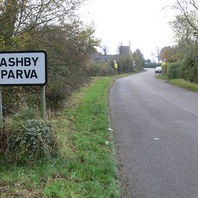
Viking Names
Ashby Parva
Ashby Parva, in the Guthlaxton Hundred of Leicestershire, is an Anglo-Scandinavian hybrid from Old English æsc ‘ash-tree’ and Old Norse by ‘a farmstead, a village’. There may have also been possible influence on the first element from Old Norse eski ‘a place growing with ash-tree’ or Old English esce ‘a stand of ash-trees’. Affixes such as the Medieval Latin parva ‘small’ and Middle English litel ‘little’ were variously added to different forms of the name to avoid confusion with nearby Ashby Magna.
Read More
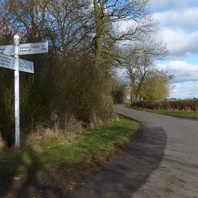
Viking Names
Carlton Curlieu
Carlton Curlieu, in the Gartree Hundred of Leicestershire, is a partly Scandinavianized form of Old English Ceorlenatun, from Old English ceorl (ceorlena genitive plural, Old Norse karl, genitive plural karla) ‘a freeman of the lower class, a peasant’ combined with Old English tun ‘an enclosure; a farmstead; a village; an estate’. The feudal affix Curlieu is the family name of William de Curley who held the manor in 1253.
Read More
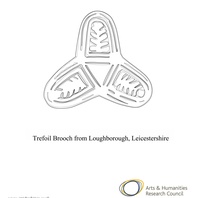
Viking Designs
Drawing of a Trefoil Brooch
A drwaing of a copper alloy trefoil brooch of a type that would have been common in the Danelaw. Trefoil brooches were characteristically Scandinavian women’s wear. However, many examples found in the East Midlands were probably made in the Danelaw, and may have been copies of Scandinavian styles, instead of being imported from Scandinavia. Scandinavian brooches came in a variety of sizes and shapes which included disc, trefoil, lozenge, equal-armed, and oval shapes. The different brooch types served a variety of functions in Scandinavian female dress with oval brooches typically being used as shoulder clasps for apron-type dresses and the rest being used to secure an outer garment to an inner shift. Anglo-Saxon brooches do not match this diversity of form with large disc brooches being typical of ninth century dress styles with smaller ones becoming more popular in the later ninth and tenth centuries. However, since disc brooches were used by both Anglo-Saxon and Scandinavian women they are distinguished by their morphology. Scandinavian brooches were typically domed with a hollow back while Anglo-Saxon brooches were usually flat. Moreover, Anglo-Saxon brooches were worn singly without accompanying accessories.
Read More
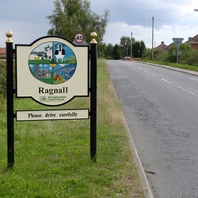
Viking Names
Ragnall
Ragnall, in the Bassetlaw Wapentake of Nottinghamshire, is a hybrid name formed from the Old Norse male personal name Ragni and the Old English element hyll ‘a hill, a natural eminence or elevated piece of ground’.
Read More
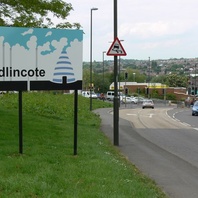
Viking Names
Swadlincote
Swadlincote, in the Repton and Gresley Hundred of Derbyshire, probably comes from the Old Norse male personal name Svartlingr and the Old English element cot ‘cottage, hut, shelter, den’. However, it is possible that the first element may equally well represent the Old English male personal name Sweartling.
Read More
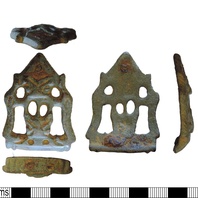
Viking Objects
Stirrup-Strap Mount (PUBLIC-ED7865)
This example of an Anglo-Scandinavian copper-alloy stirrup-strap mount is classed as a Williams Class B Type 2 and is decorated with openwork zoomorphic designs.
Read More
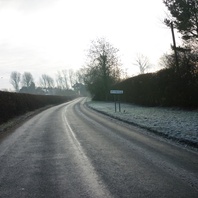
Viking Names
Stixwould
Stixwould, in the South Riding of Lincolnshire, is a hybrid place-name from the Old Norse male personal name Stigr and Anglian wald ‘a forest; high forest-land’, which is topographically appropriate.
Read More
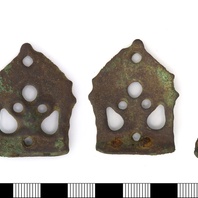
Viking Objects
Stirrup Mount (LEIC-113224)
Early medieval copper-alloy stirrup mount rectangular in form and cross section. The main decoration consists of a trilobed motif, cebntrally placed, which sits on a very short wide shaft running to the objects base. The mount is classified under Williams class B, type 1, group 3.
Read More
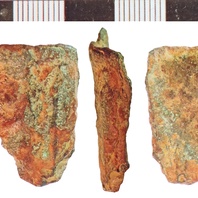
Viking Objects
Scabbard Chape (NLM-6C0242)
This possible scabbard chape fragment is very damaged but the reddish tint is often characteristic of Anglo-Scandinavian metalwork
Read More
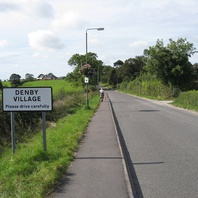
Viking Names
Denby
Denby, in the Morleyston and Litchurch Hundred of Derbyshire, takes its name from the Old English ethnonym Dene ‘a Dane’ and Old Norse by ‘a farmstead, a village’. Traditionally, the place-name has been interpreted as referring to a settlement of Danes. However, the exact implications of such a name are not yet fully understood and are the subject of ongoing work by Dr Jayne Carroll of the Institute for Name-Studies, University of Nottingham.
Read More
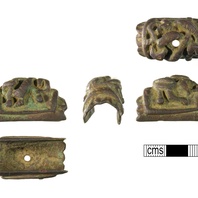
Viking Objects
Urnes-Style Sword Mount (WMID-2FF927)
A cast copper-alloy fitting with Urnes-style, zoomorphic decoration, found near Boylestone, Derbyshire. It may have been a pommel mount and, if so, would have showed off the wealth of the owner.
